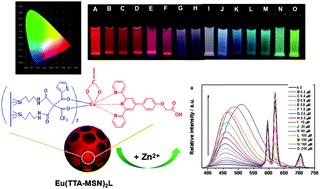Full-color emission of a Eu3+-based mesoporous hybrid material modulated by Zn2+ ions: emission color changes for Zn2+ sensing via an ion exchange approach†
Abstract
We reported on the fabrication of a multicolor fluorescent sensor for Zn2+ ions based on the Eu complex functionalized mesoporous hybrid material Eu(TTA-MSN)2L (TTA: 2-thenoyltrifluoroacetone, HL: 4′-(4-carboxy-methyleneoxyphenyl)-2,2′:6′,2′′-terpyridinel). The material was characterized by Fourier transform infrared spectroscopy, X-ray diffraction, transmission electron microscopy, and N2 adsorption measurements. The results revealed that the material preserves mesoscopically ordered structures and exhibited highly uniform pore size distributions. Spectroscopic analyses showed that the mesoporous hybrid material Eu(TTA-MSN)2L exhibited the characteristic emission of Eu3+ ions, reasonably long lifetimes (0.62 ms), and high quantum yields (18.4%). Moreover, the material displayed a highly selective and sensitive function toward Zn2+ ions in aqueous solutions. This sensing function could be attributed to the cation exchange of Eu3+ in the parent material Eu(TTA-MSN)2L with Zn2+. More importantly, by only modulating the concentration of Zn2+ ions in the water solution of Eu(TTA-MSN)2L, a tunable full-color emission (including white-light emission) can be generated under single-wavelength excitation. To our knowledge, this effort is the first example of a multicolor emissive sensor for Zn2+ ions in water solutions based on lanthanide mesoporous hybrid material.



 Please wait while we load your content...
Please wait while we load your content...